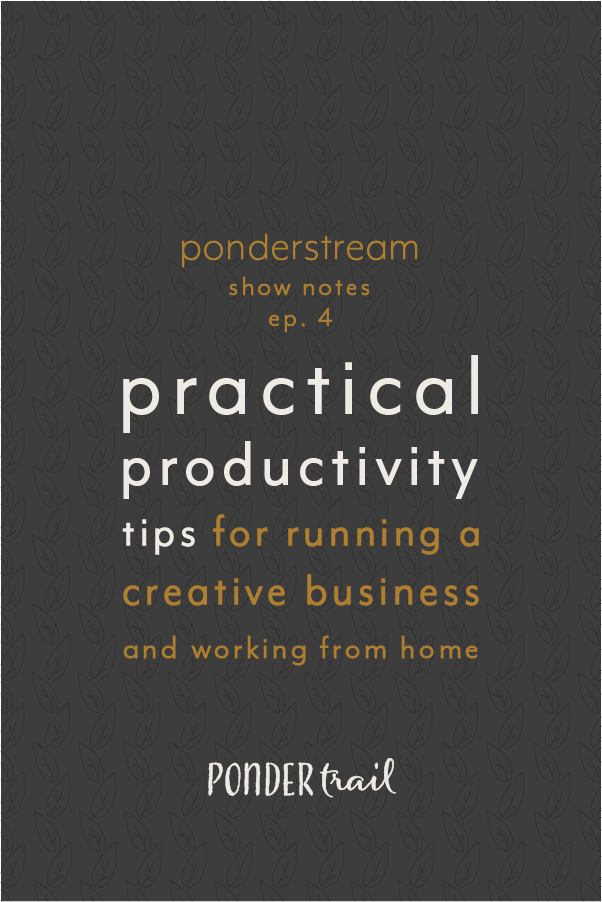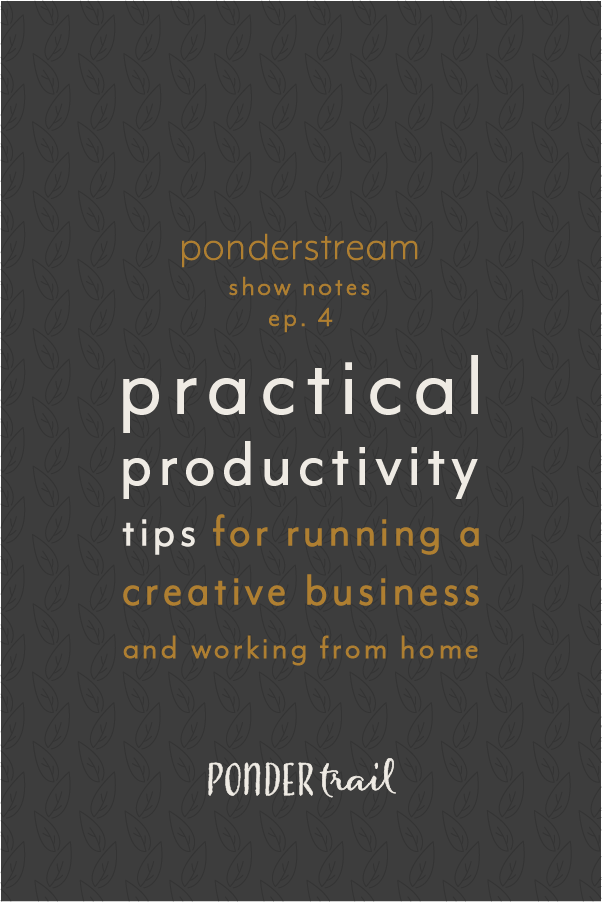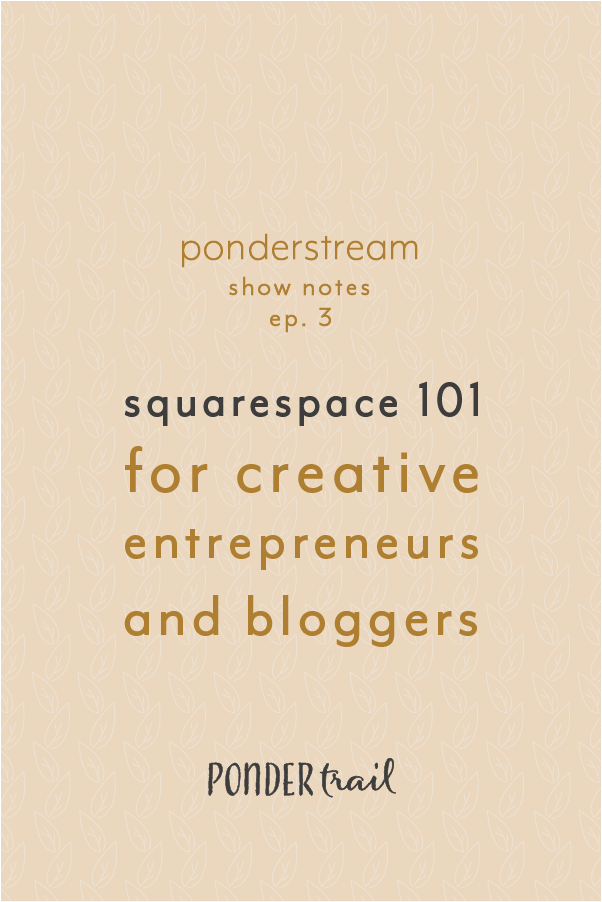Practical Productivity Tips for Running a Creative Business and Working from Home // Ponderstream Show Notes
video + blog post
Missed joining this one live? Register for next week’s Ponderstream webinar here.
watch the Ponderstream episode:
blog post recap + show notes:
The Main Idea behind “Productivity”
The ultimate goal of productivity is to get rid of busyness and replace it with efficiency, effectiveness, and progress.
As creative business owners, hustling often works its way into our lifestyle. We have so many ideas and things to do. But sometimes that mentality pulls in too many things that aren’t actually helpful or productive in the long run. On the outside, it can look like we’re getting lots done, while in reality, we’re running around in circles.
Don’t simply add to your hustle for the sake of feeling busy. Instead, you want to see progress from the time you put into your business, and you want your time to have a big impact. True productivity looks like speeding along the process of reaching your goals or helping you stay on track.
So keep that in mind while trying to be more “productive."
HOW TO ADOPT A PRODUCTIVE MINDSET
Mindset is key.
Productivity is a way of going about your day. It’s not just a one-time thing you check off your to-do list and move on from. Keep it in the back of your mind until it becomes more natural.
This will help increase your productivity over time, too, even if you’re already fairly efficient. The more you adopt this mindset, the more your productive growth will continue long after you read this blog post and watch the video.
Here are three steps to guide you:
1 // Identify Problem Areas.
When it comes to productivity, understanding what to fix is the first step to growth. So spend some time in self-reflection to figure out where you can get better.
Where do you need improvement? What can you do to change and become more productive?
Ask yourself questions about what you get done, what you don’t get done, and why.
Try tracking your day to determine your time-wasting tendencies.
For example, you might find that you end up scrolling through Instagram longer than you intended.
Analogy: Think of your day like a bucket that start out full each day. And think of your productivity problems as holes in the bucket. Your water magically transforms into whatever you spend your time doing.
If most of your water leaks out each day without much to show for your time, figure out what caused the holes and the best way to repair them.
The goal is to have a full bucket by the end of the day—with lots of progress inside—whatever that might look like for you.
2 // Commit to New Habits.
Embrace the change and make it a new practice. Prioritize efficiency. Commit to developing your productivity skills and what will work better going forward.
3 // Practice, and See Progress.
It’s true that practice makes perfect. Productivity is a skill, so know there will be some growing pains, and be willing to take on the challenge. It will start to come naturally the more you practice it.
TIPS + STRATEGIES TO INCREASE PRODUCTIVITY
1 // Create a morning routine.
A set routine helps you get into the zone each day because it creates a rhythm. This is especially true with morning routines. So fine-tune your waking hours to be productive, and that efficiency will likely carry on into your day.
Wake up at the same time each day. Think about what will kick-start your productivity, and incorporate those things into your morning.
It might be ready-to-brew coffee, a cozy blanket, a fruit smoothy, a peek at your “WHY” and your goals—anything to help propel you into action.
The laziness of a slow morning often tends to linger, so the smoother you make those first few hours, the more you will likely accomplish throughout the rest of your day.
2 // Hit the ground running each day.
Know your focus and to-do list items for the day. Prepare the night before so you can wake up and get straight to work. This cuts out decisions, which can slow down the start of your day.
Just a little bit of time at the end of the workday to jot down tomorrow’s plan will mean you won’t need to remember where you left off since it will already be mapped out for you.
3 // Implement a simple goal planning system that doesn’t drag on and is easy to follow.
The purpose of planning is to help with organization and with moving forward—not to get hung up in the “planning stage.” So spend less time planning and more time DOING.
The best way to do this, it to follow a streamlined goal planning process that works. You can check out this previous Ponderstream Episode on how to break goals down into small, daily steps.
4 // Use time blocking in your schedule.
Time blocking your day is a great way to set boundaries with your time. Think about setting aside time to focus on a specific task and ONLY that task. Block out anything else that pops into your mind or tempts you with distraction.
This technique not only helps you creates boundaries but it also helps structure and plan your day so you stay on track.
5 // Keep your daily agenda simple and realistic.
There’s no point in setting yourself up for failure by listing 100 items on your to-do list. Instead, focus on 1-3 goals each day.
It prevents you from being overly optimistic, and it gives you a huge sense of satisfaction when you’re able to check off all of your listed items at the end of the day.
It might not sound like enough, but you can always add more tasks if you complete them all ahead of time.
Consider calling it a “must-do” list to help you be extra intentional about what you write down and plan to do.
6 // Focus on ONE task at a time.
I like multitask with things around the house like cooking and laundry and cleaning. And I can do it fairly efficiently. But not when it comes to business. I get nowhere.
In fact, studies show that multitasking can make your productivity reduce by 40%.
Additionally, after getting distracted, it takes 23 minutes to refocus.
Rather than bouncing back and forth, allow your brain to dial in and focus on each task, one by one. You get more out of your time because it lets you get into a “deep work” state instead of constantly switching between tasks and trying to refocus each time.
Strive to do one type of task at a time. Instead of checking emails while writing a blog post or browsing Instagram while mapping out your content calendar, choose just ONE thing to do and complete.
Once you’re done, you can move onto something else.
7 // Track your time.
Each time you sit down to work, track your time. It creates more pressure and accountability, so less time is wasted.
I like to use Toggl, but you can use your phone or any old timer. Document what you do and how long you spend doing it.
At the end of the day or week, you’ll have a really good idea of where your time went.
Toggl is great because you can see reports of your time. And you can add project tags so it makes it really easy to see where your time is going. I use this feature to pinpoint areas that I want to improve in and get faster at.
8 // Add incentives, and reward yourself.
Think of a creative few ways to add incentive. It might look like an extra break during your day. Or extra time for your favorite hobby. Or even a long weekend off at the end of a productive month.
Small rewards can be a great way to keep your productivity up.
STAYING FOCUSED WHILE WORKING FROM HOME
The increased amount of distractions is often the biggest struggle of working from home.
1 // Keep personal tasks and business tasks separate.
Figure out the best way to structure your day so you can stay focused on work during work time. Don’t try to cook dinner and write a blog post at the same time.
It cuts out the risk of distraction, and it’s much easier to stay focused and get your work done. Plus you don’t run the risk of accidentally typing your dinner menu somewhere within your blog content.
2 // Keep your home tidy.
This gives your mind space to think instead of constantly being distracted by the mess in the corner.
I can’t work in a messy space, I know some people can, but I end up going over and cleaning it up.
So dedicate a part of your day to keeping your home tidy and clutter-free. It can go a long way for your productivity.
3 // Create a dedicated workspace. Or a few workspaces.
Have a space that’s set up to work and has everything you need.
This might be your notebook, to-do list, water, charging wires, or a cup of tea.
Keep everything nearby so you don’t need to interrupt yourself to go grab something mid-task.







